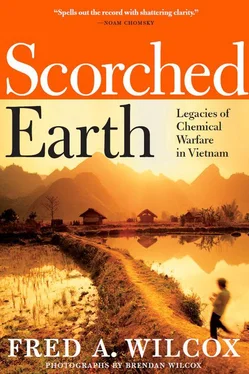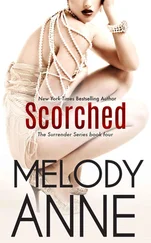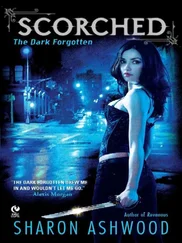The Court realized that the companies clearly knew there were scientific methods for reducing the content of dioxin in Agent Orange that they did not pass on to the government. But that was not enough to sustain the plaintiffs’ appeal. Because, said the Court, even if the defendants had disclosed this information to the government, it wouldn’t have made any difference; the government was going to use defoliants in Vietnam anyway.
“Now, what the court is actually doing here is reading into the intent of the military command and the government procurement people.”
This argument, Dean explains, is disingenuous because the minute Ralph Nader’s raiders leaked the study that Bionectics labs conducted for the National Cancer Institute—the results of this study had been kept under wraps—the military ended the Ranch Hand missions in Vietnam and, soon, issued orders to stop using Agent Orange.
“For the court of appeals to say that the government would have continued defoliation missions, even if it knew the dangers of dioxin, is nonsense.”
Dow and other companies did have superior information, and they did not pass it on to the government. Dow found out about dioxin when employees developed chloracne, an indisputable symptom of dioxin exposure, after workplace accidents. Dow even stopped production in one of its facilities, contacted this German company that had experience with dioxin, and called a meeting in March 1965 in Midland, Michigan.
“They called in representatives of all of the companies—Monsanto was not present, but did correspond with Dow about this—that were supplying Agent Orange at that time. And they said: ‘Look, we’ve discovered this stuff called dioxin in our product. It’s not intentional, but it’s there.’ And Dow said it knew about some of the effects of this chemical. The company knew that dioxin causes chloracne, and that dioxin is conceivably a potent carcinogen. There was already evidence that dioxin causes liver damage, and porphyria cutanea tarda . It’s systemic and toxic to the system. Dow knew all this, and the company was worried that if the government found out, it would step in and regulate the manufacturers. They’d lose a lot of money. So, said Dow, ‘Let’s just keep this to ourselves.’”
“Agent Orange was twenty-five times more concentrated than domestic 2,4,5-T.
No doubt that Dow made a deliberate attempt not to communicate all it knew about dioxin to other manufacturers.”
Dean points to a meeting at the Army’s Edgewood Arsenal to evaluate the safety of Agent Orange and its effects on humans and animals, a meeting at which the chemical companies failed to report their own workplace incidents. Agent Orange, they said, was harmless to humans and animals. Later, commanders in the field, not knowing any better, assured soldiers that defoliants were safe.
“Clearly, those companies were not forthcoming with what they knew about dioxin. And it’s important to note that chemical companies do not assert in court that they told the government what they knew about Agent Orange.
“Their argument is simply that the government knew about dioxin. And they argue that what they knew is insignificant because it doesn’t approach the level of proving causation. Companies continue to argue that there is no proof that dioxin causes illness, even cancer. They argue that if you can’t prove causation now, forty years after the war, how could you expect us to have known about it, or to have told anyone about it, back then?
“The chemical companies concede that there might have been a few minor complaints about Agent Orange, and a few insignificant incidents in the workplace over the years, but it’s nothing to worry about. After all, there’s no sound medical proof that dioxin harms human beings, which is why they say they didn’t report these minor problems.
“At the meeting in 1965, Dow announced that the company has a gas chromatography machine. The lowest amount of dioxin this machine can detect in 2,4,5-T is 1 part per million (ppm). Since that was the lowest level their scientists could detect, Dow concluded that this must be a safe level. During the war, none of the manufacturers kept dioxin down to that level. There were measures of dioxin up to 40 to 50 ppm, even 140 ppm. Dr. Jean Stellman, a researcher at Columbia University, estimated the average amount of dioxin in Agent Orange to be 13 ppm, while Jack Weinstein, for purposes of his ruling, decided that the average was 10 ppm. Dow and Hercules produced the ‘cleanest’ Agent Orange, while Monsanto and Diamond Alkalide made the ‘dirtiest.’
“So, according to Weinstein, you have a substance that is 999, 990 parts harmless herbicide, and ten parts poison. He didn’t like it when we characterized dioxin as a ‘poison.’ And he said that (I’m quoting him here) ‘international conventions prohibit the use of chemical weapons, and if the chemical companies used dioxin, a poison, that would have been a violation of international law.’
“According to the companies, herbicides landed on the trees in Vietnam, and when it rained, the defoliants washed away. Unfortunately, we dumped over twenty million gallons over ten years.
“Scientists don’t completely understand the causes of cancer—could be genetics, substance abuse, living near toxic waste dumps—but they have developed the ability to study an individual’s genetic system, and some people seem to be genetically immune to dioxin, while others appear to be susceptible. So if you perform a study on exposure to dioxin in which you consider a person’s genetic system, you may get a very good idea of an individual’s susceptibility to toxic chemicals. Since no such studies have been performed in Vietnam, for now we have to rely on other forms of proof.
“Carcinogens and teratogens increase one’s chances of giving birth to deformed children or developing cancer. If exposure to a toxin makes it twice as likely that you’re going to develop an illness, then it’s obvious that the drug increases the incidences of developing that illness, and it probably caused the illness.
“If you can prove that there’s a doubling of birth defects or cancer after you’ve been exposed to a chemical, then for the purposes of our legal system, you’ve proven that there’s a greater than fifty percent chance of correlation. It doubles your chance of getting an illness. And what’s important here is that if you have 1,000 Vietnam veterans, you’re not to going to see all of them come down with cancer. All of their children are not going to be born with birth defects. What you’re going to find out is that maybe five of these veterans will die young from cancer, but what you are going to see is that out of those exposed to Agent Orange, maybe twelve or thirteen are going to die young from cancer.
“To a lay person, that might not be a big difference, but to a scientist that’s a huge difference. If you can isolate that, and make sure that those twelve are not dying from something else, then that could be a statistically significant result. If you researched even this small sample, and you have twelve instead of five veterans dying young, then you may have proven your case.”
The subway squeaks, rattles, and shakes its way through Manhattan, dips under the East River and rolls into the vast stretches of Brooklyn.
In 1000 BC, Chinese armies used arsenic smoke in battle; 600 BC, Assyrians poisoned enemy water supplies with rye ergot; 429–424 BC, Spartans used flames and toxic smoke created by burning wax and sulfur against Athens and its allies; 82–72 BC, Romans used “toxic smoke” against the Charakitanes in Spain, causing pulmonary problems and blindness; in 1763, the British gave smallpox-infected blankets to Indians at Fort Pitt, Pennsylvania; 1915–1916, the Germans used chlorine gas against Allied forces at Ypres; British forces retaliated with chlorine gas, to which the Germans responded with mustard gas; from 1937–1945, Japan used gas and bacteriological weapons in China; 1939–1945, Germans, Austrians, and Japanese poisoned, burned, starved, shot, and conducted experiments on human beings; 1987–1989, Iraq used chemical weapons against its Kurdish minority population. 7
Читать дальше












